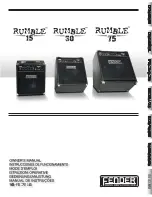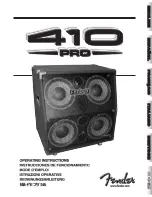
to become loose, vibrate, and
provide undesired string noise.
Pliers may be used to squeeze the
saddle from either side to stop
roller rattle. It is not generally
necessary for the roller to spin
freely as the string will easily slide
across the brass surface during
tuning or vibrato use.
Rickenbacker basses come
equipped with bridge assemblies
that have just two hex height ad-
justment screws, located at either
side of the bridge assembly. To
raise the strings, turn each of the
height adjustment screws clock-
wise. To lower the action, turn the
screws counterclockwise.
Certain models, such as those in
the 650 and 4004 Series, are
equipped with a special bridge/
tailpiece assembly, in which the
individual bridges are adjusted
separately for each string. Each
bridge piece is adjusted by two hex
screws, located on either side of
the string it supports.
To adjust one of these bridges, first
loosen the locking screw, if present,
so that an adjustment can be
made. Then, using the metric
wrench supplied with the instru-
ment, turn each of the two adjust-
ment screws clockwise to raise the
string, or counterclockwise to lower
the string.
Some models may be equipped
with saddles which have threaded
rollers to allow for string centering.
Lift the string and turn the roller to
move it to either side as appropri-
ate.
String Length and Pitch Adjust-
ment
Each string saddle on Ricken-
backer guitar and bass bridges may
be adjusted for perfect pitch or
intonation. Each saddle is set at the
factory for the gauge of Ricken-
backer strings that come with the
instrument. If the pitch should
become slightly sharp or flat, or you
desire a change from standard
Rickenbacker string sizes, you can
readjust the pitch by turning the
saddle adjustment screws on the
back side of the bridge.
When making any pitch adjust-
ments, first loosen the string, then
make an adjustment, and finally
bring the string back up to pitch. If
another adjustment is necessary,
repeat the process until the intona-
tion is correct. This method protects
the strings from damage.
First, check the pitch of each string.
If the string pitch sounds flat when
played at the 12th fret as compared
to the open harmonic at the fret,
turn the length adjustment screw
counterclockwise to shorten the
string. If the string sounds sharp to
the harmonic, turn the screw clock-
wise to lengthen the string.
It is vital that the neck is dead
straight before making intonation
adjustments as the location of the
bridge components was chosen on
the basis of a well adjusted instru-
ment.
Additionally, the bridge baseplate
on most 300 and 600 series guitars
is adjustable for coarse intonation
to allow use of a wider range of
strings. Loosen the baseplate and
move it to the position required.
Generally speaking, flat wound
strings require the bridge to be
closer to the tail of the instrument
while round wound strings favor a
position toward the neck. Carefully
re-tighten the baseplate before
restringing.
Hi Tek
TM
Vibrato
Intonation and individual string
height adjustment is accomplished
in the same fashion as the 650
Series fixed bridge assembly.
Simply use the hex key to raise or
lower the saddle and use a small
screwdriver to move the entire
saddle forward or back to correct
for pitch as described above.
The height of the handle is a direct
function of string tension and can
be adjusted by removing the cover
on the back of the guitar to access
the vibrato springs. Tightening the
retaining screw will cause the
handle to rise away from the body
while loosening it will bring it closer
to the instrument. It may be neces-
sary to add or remove a spring
when changing to a string type of
significantly different tension.
Note that all adjustments on this
type of bridge are interactive, i.e.
one adjustment may affect another.
Make sure to fully retune the instru-
ment each time an adjustment is
made before making another one to
minimize this effect.
Accent
TM
Vibrato
This vintage replica vibrato assem-
bly does not have the adjustability
and precision of modern vibrato
assemblies but does eliminate
entirely the friction of springs and
bearings. The only adjustment is
that for handle position which may
be loosened with a screwdriver and
retightened after positioning the
handle to the desired location.
Kauffman
TM
Vibrato
In keeping with 1950's specifica-
tions, this is a sideways vibrato,
unlike most vibrato units which
operate in an up-and-down motion.
It can be neutralized by either
removing the bar or gently turning
the tip of the bar towards the pick-
guard and out of the playing field.
This authentic replica shares the
shortcomings of the original design.
Specifically it may not always
perfectly return to pitch and may
produce some noise of its own
Содержание Guitar and Bass
Страница 1: ...Guitar and Bass Care Maintenance Manual...


























